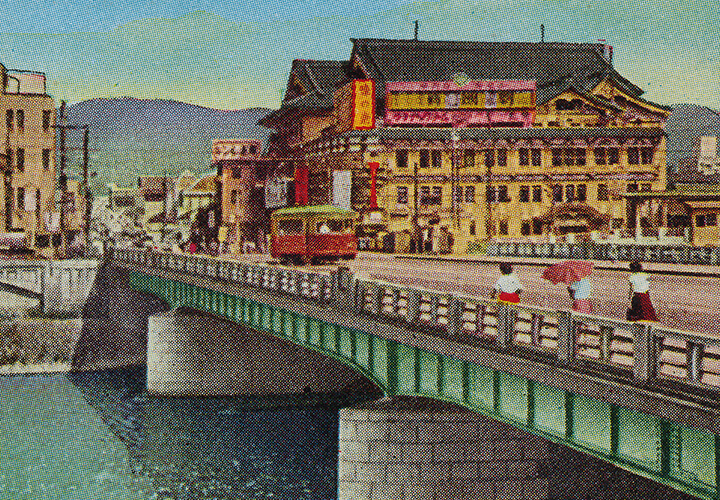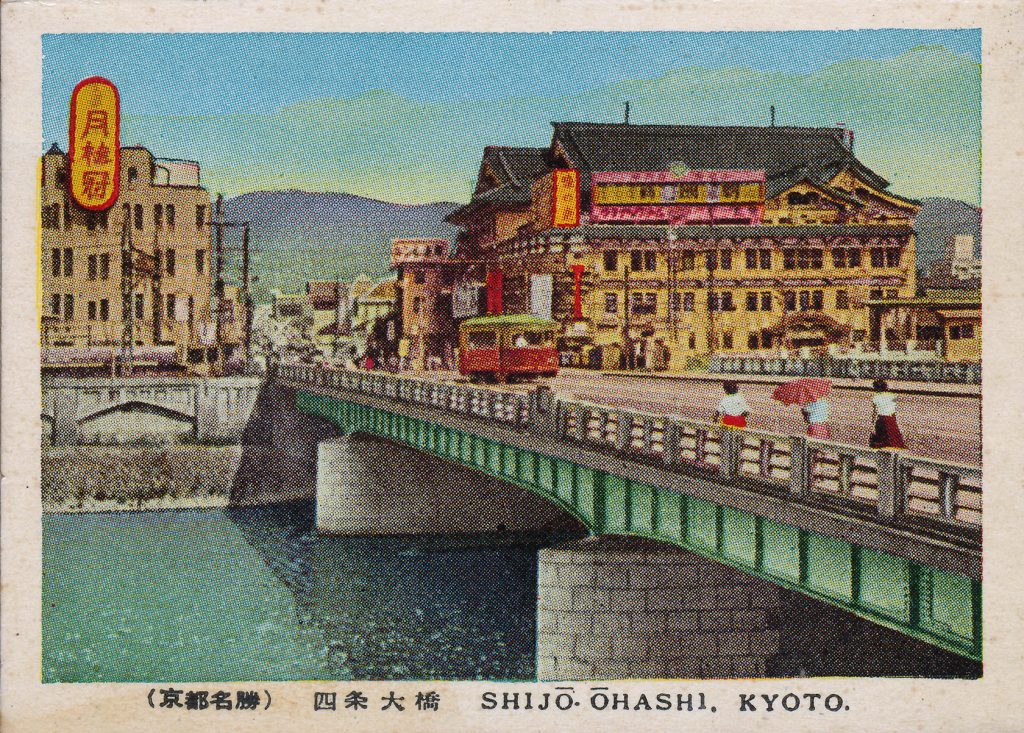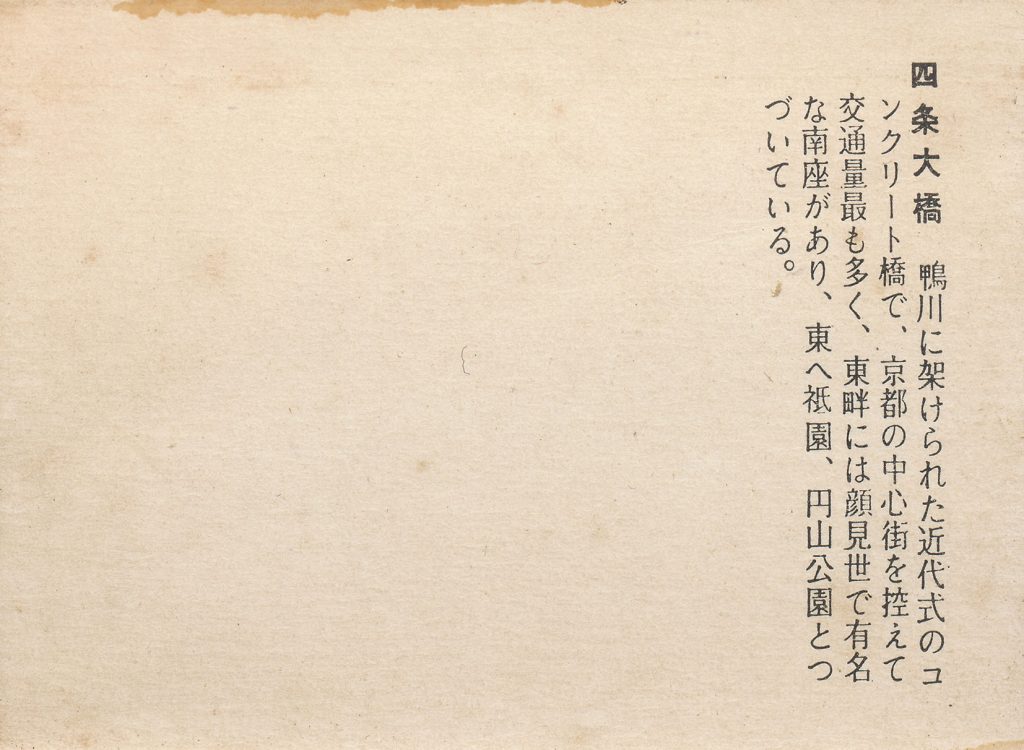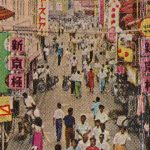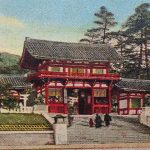豆本の12ページ目、四条大橋と南座を写したもの。
南座は2017年2月現在休館中の様です。
豆本のまとめページはこちら。
四条大橋
鴨川に架けられた近代式のコンクリート橋で、京都の中心街を控えて交通量最も多く、東畔には顔見世で有名な南座があり、東へ祇園、円山公園とつづいている。
八坂神社の「社家記録」によると、1142年(永治2年)に勧進により架けられたという。以後何度も水害により流失し、そのたびに架け直されている。平安時代末期から鎌倉時代にかけては、六波羅が鴨川の東にあったことから重要性が増し、幅の広い橋が架けられていた。近世には三条大橋や五条大橋が街道の起点(終点)であったのに対し、四条大橋は八坂神社への参詣路であり、幕府の管理下になかったことから、これらの橋に比べ小さな橋であった。
幕末の1857年(安政4年)にようやく石造の橋に架け換えられ、さらに1874年(明治7年)には鉄製に架け換えられた。このときは建設費の償還のため通行料をとっていた。1913年(大正2年)には京都市電の開通とそれに伴う道路の拡幅のため、鉄筋コンクリート製のアーチ橋に架け換えられた。しかし1934年(昭和9年)の室戸台風・翌1935年(昭和10年)6月の水害でアーチ部分に流木などが引っ掛って水をせき止め、周辺に大きな被害を出したため鴨川の川底の掘り下げに併せて架け換えられることになり、1942年(昭和17年)に現在の橋が架けられ1965年(昭和40年)には高欄部分が新設された。
出典:Wikipedia
南座
出雲の阿国が”かぶき踊り”をはじめた歌舞伎発祥の地で、元和年間(1615~1623)京都所司代によって公に許可された七つの櫓の伝統を現在に伝える唯一の劇場。
1906(明治39)年以後、松竹(株)が経営。1991(平成3)年、外観はそのままに設備、内装などを一新、最新設備の近代劇場に改修された。
1996(平成8)年、国の登録有形文化財として登録された。
2016(平成28)年1月より一時休館し、改修工事が予定されている。
出典:京都観光Navi
四条大橋から建仁寺の方へ川沿いに歩いた事があるのだけど、歴史のある大きな建物が沢山あって、ここはなんてお店なんだろう?とワクワクしました。
とくに向こう岸の建物が気になって。
この付近にはお洒落なお店もたくさんありますね。
minä perhonenの京都店はビルごと可愛くて、素敵な空間でした。
クリックで大きなサイズの画像がご覧いただけます。
Shijo-Ohashi,Kyoto.
This is 12 page of an old miniature book of Kyoto.
A picture in Shijo Ohashi and Minami-za.
A summary page is here.
The fourth bridge is called Shijo Ohashi Bridge. Everyone must have walked across this bridge when they visited Kyoto. It functions as an entrance to downtown Shijo Kawaramachi. There is one practice hall for Maiko and Geiko at Pontocho Street. In May, the event ‘Kamogawa Odori’ (traditional dance performance by Maiko and Geiko) is held. Their performance is so beautiful, like a dream. If you walk down east a little more, you will see Yasaka Jinja Shrine. It is a major sacred place of the Gion Matsuri which is a famous festival held every July. Yasaka Jinja Shrine is also famous as a place which is used for other important rituals – people grieved here and held memorial services for those who had died of plague because of the repeated floods. We could say that Shijo Ohashi is a bridge that connects people who are alive and the spirits of people passed away.
Source:The Kyoto Project
Minami-za (南座 Minami-za) is the primary kabuki theatre in Kyoto, Japan. It was founded in 1610 as Shijō Minami-za. The current building with 1,086 seats was built in 1929.
…
Minami-za is one of the earliest of the seven officially licensed Kabuki theaters built in the early Edo period (1615-1623) in the Shijo Kawara area in Kyoto, even before Tokyo and Osaka.
The current Minami-za theater was built in 1929 in the architectural style of the Momoyama period, with a gabled roof and a traditional turret marking the official approval of the government. In 1991, after the end of the Showa period, the interior was drastically refurbished and modern stage mechanism was installed.
In 1996, Minami-za was registered as a Japanese Tangible Cultural Property in respects to its historical architectural value in connection to the city of Kyoto.
Source:Wikipedia
Old architectures also remain now around here.
This street mixed New things and old things.
I like that.
When you click a picture, a big image (equal to 600dpi) is indicated.

